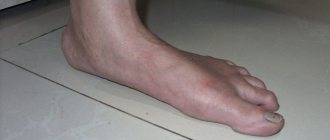My four year old daughter sometimes asks to leave the door to her room open so she can see the light from the other room. This makes her feel calmer and she falls asleep faster. But if she suddenly wakes up at night and doesn’t see the light, she starts screaming: “Who closed the door?” She feels like she was deceived.
She, like that baby, fell asleep in some conditions and woke up in others. But she is already four years old, she can speak and express her dissatisfaction with the changed circumstances in words. This is extremely difficult for a small child to do. He can only show this by crying. But most parents don't understand what this means.
To help your baby sleep peacefully, try putting him to bed sleepy but not asleep, this will help him wake up in the same conditions as when he fell asleep, and it will be easier for him to fall back to sleep without additional help.
Everything you need for healthy sleep
Sound and healthy sleep is vital for a person, and a child in particular. Physical energy, excellent mood, optimism in life, the ability to focus attention on what is important, patiently cope with intellectual tasks, remember and assimilate knowledge and skills - components of a child’s healthy growth and development.
Buying your first crib is a reason for a lot of doubts and worries. What if the baby prefers to sleep together? Is it necessary to add a new line of expenses to a family budget that is already bursting at the seams? And if so, how to most rationally distribute all purchases related to separate sleeping - so as not to miss and not buy too much?
While you are still preparing for the arrival of your baby and don’t know exactly how circumstances will turn out later, buying a separate crib seems like a moot point. To avoid throwing money away, first choose a crib that will be useful to you in any case.
Rational choice:
- Stroller with detachable cradle. For the first time, such a cradle is an ideal option for separate sleeping. Having lulled your baby in a stroller, you can always move him to a new place without moving him or interrupting his sleep. The main thing is that the bottom of the cradle is not curved, and that the mattress meets orthopedic requirements. If the cradle is to perform the function of the baby’s first crib, when purchasing, you should pay special attention to its weight and the convenience of the release mechanism.
- Transformable bed. Sliding sides, a lowering bottom and/or the ability to attach it to the edge of a large bed (on which you sleep) largely determine the choice of zealous parents. And although such cribs are often more expensive than regular ones, this is a kind of “insurance” for the future.
- Cot-playpen. Not the most popular option among modern parents. But portable playpens are equipped with many useful functions: they can have music, rotating mobiles, vibrating mattresses, a night light, and a changing board. But most importantly, the playpen will serve both during travel and in the future, when you start using it not as a crib, but for its intended purpose - for games. There is one thing: if the baby still prefers to sleep separately and spends most of his time in playpen, it is worth buying a separate high-quality mattress, since those that come with the playpen often do not meet orthopedic requirements. After purchasing a new mattress, you will most likely have to cut it to fit the size of the playpen (they often differ from the standard). Please consult the seller regarding this issue before purchasing.
- Cocoon bed. An ergonomic crib that imitates the position of a baby in the womb. Used for up to 4 months. This is an expensive option that requires replacement after just a few months of use.
Irrational choice
- Cradles, cradles. Of course, the assortment of designer cribs for babies can’t help but evoke affection: some of them resemble nests, others look like old village “wobbly beds”, and others are even covered with a waterfall of lace canopies. All this can turn out to be a simple interior decoration. And even if such a cradle serves the baby in the first months of life, after he learns to sit down, it will turn out to be not only unnecessary, but also dangerous.
- Pendulum beds without the possibility of fixation in one position. Nowadays, fewer and fewer such models are being produced, but they can still be found among inexpensive ones. When the baby learns to roll over and sit up, such a crib will turn from a place to sleep into a playground for endless games.
It is not enough to buy just one crib. It comes with a whole set of additional equipment:
- Mattress (choose orthopedic);
- 4 – 10 oilcloths per mattress - it is advisable to use special oilcloths, which are covered with fabric on top so that the baby does not sweat, or disposable waterproof diapers;
- 6 – 10 cotton sheets/diapers;
- 2 light baby blankets or 2 – 4 sleeping bags/onesies;
- 1 warm baby blanket;
- 1 – 2 sets of soft bumpers for the crib;
- Mobile (from 3 – 4 weeks).
What you should not buy for a baby under one year old:
- A pillow (unless your doctor recommends purchasing one; usually this is a special orthopedic pillow that should help solve neck problems);
- Bed canopy/curtains (they can cause suffocation);
- Bed linen made of synthetic materials, with lace and braid, with decorative elements that can come off or crumble (this can cause irritation on delicate skin and pose a health hazard).
Offer your baby healthy and tasty “Agusha Fall asleep” products, which are designed specifically for use before bedtime. This is live drinking yoghurt with apple flavor and natural lemon balm extract, cottage cheese with strawberry, banana and natural lemon balm extract flavor, as well as porridge with prebiotics and cereals: milk-buckwheat and milk-rice with apple and pear, which will help set your baby up for a healthy and healthy life. deep sleep.
When to see a doctor
If your baby is not sleeping through the night by the time he is 6 months old, it is best to consult a doctor. Although it is unlikely that anything is wrong, the doctor will check your baby's health and be able to provide support.
Lack of sleep can be very difficult for parents. Try to develop good habits, but be flexible and make changes to your routine as needed.
Scientific article on the topic: Insomnia in infancy - no cause for concern.
How long should a baby sleep?
The answer “as much as he wants” is only suitable for children with an even, calm temperament. From infancy, they seem to have a built-in alarm clock that regulates sleep and wakefulness, and they “stick” to a fairly stable daily routine. Such children need almost no help to calm down and fall asleep, their sleep is stronger, short awakenings between sleep phases are not accompanied by anxiety and crying.
The picture is completely different for children with an active psyche: if the daily routine is not regulated in any way by adults, children become excessively tired, unable to rest between periods of high activity, become very overexcited in the evening, and spend the night in restless sleep.
- To avoid overwork and accumulation of fatigue, improve the child’s mood and provide him with the sleep necessary for development and growth, it is useful for parents to know how long the child should stay awake and rest during the day.
- Let us make a reservation that any standards are always averaged. Some children need a little more rest, others less. The most striking and unambiguous marker of satisfactory sleep is the child’s good health and mood.
- The younger the child, the more sleep he needs: a newborn sleeps almost the whole day, a one-year-old sleeps 14 hours, younger preschoolers from 3 to 5 years old - about 11 - 13 hours, primary schoolchildren - 10 - 11 hours, high school students - 8.5 - 9 hours, adults - 7 - 8 hours a day.
There is no official sleep “standard”; you can easily determine it for your child yourself if you allow him to sleep in the morning and afternoon as much as he wants. Many doctors claim that this norm for children from 1.5 to 4 years old is 11–13 hours a day, but everything, of course, depends on the individual needs of a particular child.
The duration of sleep also depends on temperament. An active baby will sleep less than his calm counterpart. Some somatic factors can also affect sleep: sudden growth spurts, teething, an impending illness, psychological factors - a change in the family situation, getting used to a new social situation (kindergarten, school).
In any case, the main task of sleep is to ensure adequate rest for the child. Lack of sleep is harmful to the body, and especially to a growing child: it can lead to chronic fatigue, nervous system disorders, decreased concentration, memory problems, and school failure.
Does a child need a pillow to sleep?
It is quite difficult for adults to accept “on faith” the statement that children under 1.5-2 years old do not need any pillows in principle. However, you will have to! The fact is that, proportionally, children under the age of about 2 years are very different from older people - they have a large head, a rather short neck and narrow shoulders. Adults use a pillow to compensate for the distance between the surface of the bed and the head, so that the neck does not bend.
But babies don’t have such a need - if you lay the baby on its side, you will see that its head lies on the surface of the bed, but the neck remains straight (because the head is still large and the shoulders are short). However, if it seems to you that your child does not sleep well at night precisely because he is simply uncomfortable, experiment with a pillow, for which a diaper folded several times will be perfect at first.
© Provided by: Woman.ru Child sleeps poorly: how to choose a pillow
How long does a child sleep from 0 to 1 year?
- 0 – 1 month. A newborn sleeps most of the day - on average 19 - 20 hours. He wakes up only to eat, does not distinguish between day and night, the day is built according to the formula: wakefulness - food - sleep.
- 1 – 3 months. The formula “wakefulness - food - sleep” remains relevant. Night sleep becomes longer, but you should not expect that a two-month-old baby will sleep 10 hours. The maximum night interval without food is 5 – 6 hours (most often no more than 4).
- 3 – 6 months. The child’s activity during waking hours increases noticeably and takes up quite a lot of energy. They can be replenished by sucking breast milk, which, in turn, again requires some effort.
- 6 – 12 months. The number of periods of daytime sleep is reduced: the baby sleeps 2 - 3 times during daylight hours, by 1 - 1.5 years - 1 - 2. Meals are not associated with sleep; there are five of them during the day. It is important to follow the rule: the child eats until he is very tired, otherwise he may refuse to eat and, having fallen asleep, will not sleep for a long time.
Sleep norms are only a rough guide. If the baby is in a great mood, he is cheerful, has a positive attitude, is enterprising and easily takes on any undertaking - a deviation of an hour in any direction is quite acceptable and normal.
But remember: according to one study on the nature of sleep, even one hour of regular sleep deprivation reduces the efficiency of brain functioning, alertness, and leads to increased fatigue in the evening. Excessive sleep is also not beneficial - it leads to lethargy, coldness, and lethargy. Knowing this is intended to remind parents to carefully monitor the amount and quality of their child's sleep.
Bathing
Swimming before bed has the most beneficial effect on sleep, you just need to follow some simple rules:
The temperature of the water in the bathroom is 36.5 - 37 ° C - this is a moderately hardening, soothing, relaxing hygienic bath. A therapeutic soothing (sedative) bath is useful when sedative herbs, pine needles, sea salt, and essential oils are additionally used.
Read the article on how to conduct coniferous-sea baths.
When the temperature of the water in the bath decreases or increases, the child may become agitated or depressed, when the child becomes overly active or lethargic, capricious.
The optimal bath temperature for a child can be determined by selection. This should be done in cases where parents notice that after bathing the child is agitated, crying, and has trouble falling asleep.
The second option for getting out of the situation of excitement after an evening bath: bathing should be moved to an earlier period, in the first half of the day or before 1 or 2 days of sleep. Again, we install using the selection method.
As you age, your response to baths may change.
Massage and physical therapy are carried out by parents before bathing; the load is set to moderate, as tolerated.
After a warm bath, the pink-cheeked baby, wrapped in a large towel, is happy and relaxed. Having changed him into comfortable clothes for sleeping (diaper for children under 1 year and a jumpsuit), fed him well, all we have to do is put him in a child’s bed. Hoping everyone can sleep soundly for the rest of the night. We wish the same to you all by giving these tips!
Sedative herbal baths
From dried sedative herbs (motherwort, valerian, peony root, mint, lemon balm, oregano, St. John's wort, hops) we make a collection in free proportion or take one of the herbs in the amount of 1 tablespoon. Pour 1 liter of boiling water into the container with the soothing collection, let it brew for 30 minutes - 1 hour. Next, filter the resulting sedative infusion through a sieve. Pour the resulting infusion into a small baby bath and add about 10 liters of warm water at a temperature of 36.5 - 37 °C.
We bathe the child in a sedative bath for 5 - 20 minutes (as tolerated), adding warmer water if necessary and maintaining the required water temperature. After the bath, you can rinse your child with 1 liter of water from a mug or under low pressure with a warm shower. Wrap in a large bath towel.
We carry out sedative herbal baths every other day or 2-3 times a week, for 10 days. Then, after 10 days, the herbs can be changed, as they become addictive and their effect is not felt. If necessary, after 1 month you can return to the previous sedative herb.
If a collection of 3 or more herbs is used, the sedative effect remains; It is not necessary to replace the grass with another one.
Sedative baths are indicated for excitable children as a gentle, often harmless, effective, traditional, proven, inexpensive, widespread, favorite therapeutic and prophylactic remedy.
If an individual adverse reaction occurs (allergies, rashes, agitation), you should cancel the baths and consult a doctor.
How long does a child sleep between 1 and 4 years old?
1 year. A child usually sleeps about 14 hours a day, of which 11–12 hours occur at night. With one daytime sleep, the period of wakefulness is 5 hours, with two - about 3 - 4 hours.
It is also important to remember about the quality of sleep: experts recommend putting your child to bed at night no later than 21:00. Deep sleep 3–4 hours before midnight perfectly restores strength, normalizes the functioning of all body systems, and energizes. The number of awakenings per night can be significantly reduced if you teach your baby the skills to fall asleep independently.
If at 1 year of age your child finds it difficult to transition from two sleeps to one, the second of them usually begins in the late afternoon and bedtime is postponed until later, use this advice: try introducing a flexible sleep schedule. Let the child sleep twice on some days, once on others. This is normal for the transition period. Be patient and your sleep patterns will return to normal pretty quickly.
1.5 years. The child sleeps approximately 12 – 14 hours. By this age, most babies switch to one long daytime nap of 1.5 - 2 hours. The optimal wake time before bedtime is 5–6 hours.
A good mood throughout the day will ensure your baby gets a good night's sleep lasting 10-12 hours. Be sure to pay attention to ensure that the baby is not tired before this. Going to bed too early leads to a long process of falling asleep. Try to find an ideal bedtime for your baby between 7:00 pm and 9:00 pm.
If you notice that after several months of good sleep, your one-and-a-half-year-old child suddenly begins to wake up frequently and takes longer to fall asleep, he most likely has a temporary sleep regression, which is caused by another growth spurt.
There are several such periods in the first years: they usually occur at the ages of 4 and 8 - 10 months, 1.5 and 2 years. Try to prevent bad sleep habits from becoming ingrained: falling asleep with a bottle, drinking sweets at night. Your patience, adherence to the daily routine, avoidance of excessive emotional stress and overwork by the time of evening bedtime - and your baby's night's sleep will be strong and healthy.
2 years. Daily sleep for a 2-year-old child is 12–14 hours, of which 1.5–2 hours are daytime rest.
- It is still important for babies to get enough sleep at night to recharge all body systems. One or two awakenings per night are within normal limits. More frequent awakenings indicate more of a developed habit than a physiological need.
- Mothers note that their 2-year-old child’s sleep is improving. This is due to the fact that the brain and nervous system are developing, the baby is actually able to sleep better than during infancy.
- The quality of a 2-year-old's nighttime sleep may be impaired if the baby sleeps too much during the day. But more often at this age, another phenomenon is observed - refusal of daytime sleep, associated with the next stage of development and growth spurt. The child refuses to go to bed during the day, takes a long time to go to bed in the evening, and while going to bed constantly tries to escape.
Nevertheless, the need for daytime sleep in children of this age remains. One-time absences are acceptable here, but the final transition to a regime without daytime rest can lead to the accumulation of fatigue and deterioration of night sleep.
Periods of no napping usually last several weeks. Try to show restraint, calmness and consistency, continue to follow the regime and focus on the age-specific sleep norm.
What can be done?
- Move developmental activities to the morning hours.
- Calm down yourself: the child will feel your tension and desire to leave the children's room as quickly as possible during the tedious daytime bedtime and will try in every possible way to prevent this.
- Follow the routine, don’t forget about the bedtime rituals (daytime rituals should be different from evening ones - you’ll have to come up with something else for this case - for example, a quiet game with dolls or a construction set will do) and give your baby as much attention as necessary.
2.5 years. Two-year-old children need an average of 12 - 13 hours of sleep per day: about 1.5 - 2 hours during the day and about 11 hours at night.
If the child finally refuses daytime rest and none of your countermeasures work, he should take the entire daily sleep requirement at night.
The main indicator that a child is ready to do without naps is his good and even mood throughout the day. No whims, sudden tears, bursts of hyperactivity, lethargy during the afternoon or early evening. The baby wakes up with a smile, spends the day actively, and goes to bed happy.
It’s good when a child can wake up on his own in the morning. If he is already in kindergarten and you have to wake him up regularly and early in the morning, evening bedtime needs to be moved to an earlier hour.
3 years. Total daily sleep is about 12 hours. With this amount of sleep at night, children can already do without daytime sleep, however, if the norm is not achieved overnight, the child may need rest during daylight hours. The daily routine of preschool institutions includes a mandatory daytime nap of 1.5 hours, and many children, having given up this “habit” at 2–2.5 years, easily return to it.
Indicators that a child can do without naps:
- Smooth cheerful mood throughout the day;
- Getting up independently with a smile and in a good mood;
- Sleep at least 12 hours at night.
The main characteristic of this age is the so-called crisis of three years: parents observe in their child manifestations of negativism, stubbornness, obstinacy, despotism, self-will, a tendency to protest and rebellion, and devaluation of the opinions of adults.
The child increasingly strives for independence, independent actions from adults. At the same time, the baby still needs support and care from the parents. Therefore, despite the fact that his desire for independence extends to issues of regime, mom and dad need to show the firmness expected of them and consistently follow a healthy daily routine.
To avoid turning bedtime into a war, start getting ready for bed early so that your baby has the opportunity to gradually calm down and go to bed voluntarily. A timer, dim lights, quiet games are a clear signal for the child that it’s time to get ready for sleep.
4 years. The baby still needs 11 - 12 hours of sleep per day. If the child continues to sleep during the day, then the duration of this rest is reduced to 1 - 1.5 hours.
Typically, between 3 and 7 years of age, an important change in daily routine occurs—the final abandonment of daytime naps. Therefore, maintaining a routine with sufficient time for night rest is very important at this stage. What should you pay attention to?
- Difficulties may arise with getting to bed, especially if the family does not have well-established evening rituals. It is necessary to begin preparing for bed in advance, allowing the child to calmly finish the game he has started - this way he will have the opportunity to gradually calm down and go to bed voluntarily.
- Going to bed is painless if in the evening the child begins to feel physically tired. However, it is important not to confuse this condition with emotional overload. The baby needs active games, but there should not be excessive emotional fatigue: this will interfere with good sleep.
- Most children at this age are not yet able to adequately assess their condition, so parents may not hear: “I’m tired, it’s time for me to sleep.” Instead, they observe whims, crying, bursts of hyperactivity, anger and aggression. Parents are required to pay close attention to such manifestations: most likely, they signal fatigue, and, therefore, the daily routine needs to be revised.
Try negotiating bedtime routines with your older child, such as setting a timer to end a game before bed or using an alarm clock as a wake-up signal. Follow your usual rituals, act confidently and consistently, and don’t forget to watch for signs of fatigue.
As a rule, children of this age are already quite ready to sleep in a separate bed and even in a separate room. It's time to talk about sleeping independently in a crib.
Causes of sleep disturbances
There can be many reasons for poor sleep in newborns at night: overwork, improper sleep schedule, and overexcitement. It is worth keeping in mind that sometimes deviations are an individual norm, because there are children who are calm in the first months of life. Some people are restless from birth and have short sleep.
“Having listened to friends whose children sleep more, mothers begin to put their babies to bed more often, thus disturbing the sleep balance. When children are awake, the so-called sleep pressure increases, and it decreases when falling asleep. The child “gets enough sleep” during the day, and this pressure decreases. At night, sleep becomes superficial, intermittent and restless, says Yulia Domanova. - Pay attention to how much the baby sleeps and how he feels after different durations of sleep. Children should sleep and stay awake at their own individual norm.”
In addition, physiological changes that occur intensively in the body of young children can affect sleep. For example, immature intestines cause problems with gases and colic.
Eternal baby. After what age should a child not be breastfed? More details
When and how to transfer your baby to a separate bed
WHO does not recommend co-sleeping due to the potential risk to the baby's health. And there is not enough space in the bed - especially for dad; at first, parents are afraid to move, and this situation interferes with the relationship between a man and a woman.
Of course, there is no consensus on the question of where it is better for a baby to sleep. Proponents of co-sleeping disagree with proponents of sleeping separately, and each side has ample arguments to defend its position.
Some parents believe that when sleeping together, the child falls asleep easier, feels safe, and it is more convenient to feed him at night. To make it easier for your baby to move out, it is better to do this between 2 and 3 years. After 3 years, co-sleeping already prevents the child from solving the problems of age - to separate psychologically from his parents, realizing and experiencing his own emotions, thoughts, needs and desires.
Experiment to choose your own option that suits both you and your child.
- The child falls asleep in his own bed, but remains in the parent's bed after the night feeding.
- Sleeping in your own crib (sometimes with the side wall removed so that it becomes an extension of the adult’s bed), closely moved towards the parent’s. In this case, it is important to remember safety and lock the bed wheels.
There are various other options invented by moms and dads in an attempt to learn how to put their children to bed faster and easier. But supporters of all approaches are unanimous on one thing: sooner or later the child ends up in his own bed, and until retirement he will not sleep next to his parents.
By the time of the three-year crisis, which begins at 2.5 - 3 years and can be easily described by the phrase “I myself!”, the child needs to allocate his own place to sleep.
In the case of co-sleeping, the algorithm for transferring to a separate crib is as follows:
- Buy a toy crib and start putting dolls and bears in it together with your child, sing lullabies to them and tell them how nice it is here;
- Buy a real crib - you can take your baby to the store with you and choose together;
- “Place” a protector in the crib - a bunny, a bear, an elephant;
- Start using your bed for naps during the day;
- If the child begins to wake up more often at night, returns to the practice of night feedings, and cries, postpone the transition and try later.
To ensure everything goes smoothly, you shouldn't:
- Combine transfer to a separate bed with weaning;
- Transfer the baby to a separate crib when he is unwell or recovering from an illness;
- Combine this process with important changes in the child’s life - the appearance of a brother or sister, the start of kindergarten, moving to a new house, the passing of older relatives, etc.
How to respond to tantrums
Some mothers believe that there is no need to react to nighttime tantrums, especially after weaning, so as not to spoil the children.
“The lack of parental response to anxiety is the perception of the child as an aggressor. And the child is not an aggressor. He doesn't know how to communicate his feelings any other way. Many psychology books for adults explain how a child's earliest feelings transform over time into adult false beliefs and feelings. You need to react if you want to raise a sensitive, kind and helpful person who knows what safety is. Weaning and not paying attention to hysterics is shifting responsibility from your adult shoulders to the shoulders of a little person. Let's say you taught him to eat at night. So why, when one day they didn’t give him the breast, did he have to deal with the problem himself? Put on a tight T-shirt (without access to the chest), take the baby in your arms and rock it,” said Yulia Domanova.
If the baby sleeps alone
In the case of separate sleeping, there is usually no question of transferring the child to his own crib, since the baby already sleeps in it. There may be a problem with visiting parents in bed at night. Often, a baby, having learned to get out of the crib, climbs under the blanket with mom and dad. If the door to the parents' bedroom is closed, then adults can find a child sleeping on the threshold in the morning. How can it be easier for a baby to stay in his crib when sleeping separately from birth?
- Hang up a night light and observe bedtime rituals, which include bathing, a fairy tale and various other pleasant activities of choice and preference.
- Don't let your baby cry alone in the crib. If it is difficult and scary for him, it is better to temporarily move the crib to the parent’s bed and give the baby the necessary support, support and protection.
In a situation where you notice that the child is clearly not getting enough sleep (becomes capricious, excitable, breaks down over trifles, may suddenly fall asleep very early), try gradually shifting the bedtime to an earlier date - 15 minutes every day, and perhaps , in just a week or two (maybe in a month) you will be able to bring the child’s life schedule to its age norm.
When is it a sign of illness?
Sleep can deteriorate due to certain diseases and conditions of the body. Poor sleep in a child is normal as long as it does not worsen his overall condition. In such cases, the body compensates for frequent awakenings at night with extended sleep.
“The problem appears when sleep fragmentation begins to spoil its quality, which in turn affects the entire body. He goes into stress mode and mobilizes all resources. In older children, a sign of poor quality sleep is a decrease in appetite. They often begin to ask for dry foods, cookies - simple carbohydrates, quick energy. She is missing due to lack of sleep. The body tries to replenish the amount of nutrients and asks for food more often, including at night. The problem of waking up at night is getting worse. If this lasts for a long time, then the need to eat at night turns into an association. We get a snowball of problems,” says Yulia Domanova.
Here, differential diagnosis and complex treatment from experienced doctors will be required.
Struggle to sleep in a crib
There are different approaches to the problem of sleep.
If you look at the root, mothers choose those theories that relieve them of stress and anxiety and help them feel like good enough parents. But with any approach, 3 years is the milestone after which a child can already sleep in his own bed.
How to help your child get used to falling asleep on his own:
- Mode. Many kids cannot fall asleep on their own, because in the life of an urban family too many events happen in the evening. Dad returns from work, the house is full of activity: washing, cooking, talking while the TV is on. In order for the baby to fall asleep without problems, the last 1.5 hours before bedtime should be very calm and measured, subject to a stable daily routine. For example, a walk, dinner, quiet games, bathing, bedtime, bedtime story. A stable routine gives your child a sense of security and prepares him for sleep. Evening rituals help to calm down after a day filled with impressions and make up his world - cozy, predictable, warm.
- Its own place. It’s good if the crib is in a separate room or isolated with a curtain or screen. This is necessary so that the child has his own separate space for sleeping: when the curtain is pulled back, the baby is still in the common world with his parents and is not sleeping. When it is closed, it is a clear signal that it is time to fall asleep.
- Helpers. There is another very important participant in the ritual of falling asleep: a bear, a bunny, a doll, an elephant - in a word, a favorite toy. The significance of this object is difficult to overestimate. He has a very serious job: instead of the mother, he protects the child’s sleep. The child transfers the feeling of security that his mother’s presence gives him to his favorite toy. That is why child development specialists call such bears, bunnies and piglets “transitory” (transitional) objects. The baby interacts with them as with living people, endowing them with the properties of the latter - this is how, in the child’s eyes, part of the mother’s power is transferred to them. A transient object has a colossal beneficial significance in the mental life of the child. True, only if the boundaries between his reality and the imaginary world are maintained. Parents don’t have to worry about a child’s obsession with his favorite toy: a bunny or a bear will not be a companion throughout childhood. Children grow up, the toys are put away in a box, sent to the closet, to the dacha, or given to other children, and the child (perhaps already a schoolboy) forgets about their existence. Also, do not worry if the baby takes a whole regiment of plush animals and a stack of toys to bed with her favorite books. This is normal and means that one bear in the scary world of dreams cannot cope and the baby calls on an entire army of loyal friends to help him.
- Night light. Another necessary item in a children's sleep corner is a night light, which provides soft, subdued light. Children are afraid of the dark, and the best way to cope with this fear is a night lamp. In addition, having a night light will protect you from the child’s requirement to leave the door to the room open. Often this requirement begins a whole series of conditions for sleep, tying parents hand and foot: keep the door open, turn off the TV in the living room, put a glass of water next to the bed and etc. The child delays the moment of going to bed, checking whether all conditions are met.
Why does a child sleep little during the day?
The importance of getting your baby enough sleep is that he can:
- grow, develop;
- improve health;
- restore strength after physical activity;
- be in mental balance.
If a child does not sleep well during the day, he will be lethargic, apathetic, irritable, and cry for any reason. The norm for daily sleep is sleep from 16 to 20 hours. About half of the time is spent sleeping during the day. The causes of insomnia during the day lie:
- in digestive problems;
- stuffiness, heat in the nursery;
- uncomfortable bed or clothing;
- bright light, loud sounds.
Children who are not accustomed to a daily routine often suffer from insomnia during the daytime. They have not developed the habit of falling asleep and waking up at the same time.
Getting used to sleeping in your own crib
The main rule for falling asleep is this: as soon as all the evening rituals are completed, the fairy tale is told and the wish of good night with mother’s kiss is also said, that’s it! No wandering around the apartment! Parents are serious in their intentions, and nothing can pity them.
The child is afraid to fall asleep alone, and he tries with all his might to attract the attention of adults. Have a drink, go to the toilet, have a stomach ache, a mosquito bites you, don’t like the noise - anything to get a little attention!
This upsets his sleep and forms a rather bad habit - using any manipulative means to force his parents to play by their own rules.
The most appropriate parental reaction is to take her by the hand and silently lead her to bed. Trying to console, reassure or, conversely, scold or shame is already an act of attention, and it means the child got what he wanted. If you silently escort your baby to bed - three, five, ten or twenty times in a row - he concludes that the parents are serious in their intentions and, obviously, it’s time to sleep.
Both adherence to the regime and firmness in bedtime require high discipline and organization from parents. Once a month, you can arrange a Break the Rules Day (for example, on Friday or Saturday) - give yourself and your child a break from routine and rituals. Make unusual food, dress up in funny clothes and ask that you not put the child to bed, but he puts you to bed.
Speaking about age-related sleep standards and strategies for complying with them, it is impossible not to mention why, in fact, you need sleep in the required amount.
Ask loved ones for help to avoid becoming a victim of postpartum depression
Often in the first months after the birth of a child, a mother is deprived of sleep. This causes her to become more tired over time. Its resource is gradually being exhausted. This can lead to postpartum depression.
Sometimes mothers come to me and ask me to teach them to love their child again. They say: “I take it out on my child. I recently hit my baby because I couldn't control my emotions. Help me learn to love my child again.”
I recommend that young mothers do not hesitate to ask for help from loved ones in everyday life or caring for a child, and try to rest more instead of some non-urgent matters. And if you feel something like this (no joy, everything is annoying, you don’t feel love for the child or constantly snap at him), you need to restore your resource, because in this state the mother will not be able to help the baby. In such cases, it is best to seek help from a psychologist or psychotherapist.
Previously, we published an interview with the director of the OMM Research Institute, Galina Malgina, who spoke in detail about why mothers kill babies and how to save a wife from postpartum depression. You can read it here.
Several reasons to improve your baby's sleep
If a child does not get enough sleep, it is obvious: his mood is noticeably low, he goes to bed and gets up dissatisfied, and in the evening he is capricious, not only in early childhood, but also during his school years. These are reactions that lie on the surface. What problems are hidden from our eyes and can be stopped by replenishing the sleep deficit?
- Development and growth of the child’s brain. The child will never sleep as much as in the first months of life (up to about six months). During the first time after birth, all systems of the baby’s body “ripen”: nervous, respiratory, cardiovascular, etc., but most importantly – the brain. This important process occurs precisely in sleep: scientists have proven that dreams contribute to the emergence of visual images and thereby stimulate brain growth.
- Restoration of strength. It is known that during sleep (its deep phase), blood flows from the brain to the muscles, and this helps to restore strength and prepare for the physical exertion of the new day. A baby who gets enough sleep is able to engage in outdoor games for as long as is appropriate for his age during the day; a child with a sleep deficit will spend the entire day in his mother’s arms or on the floor with his favorite toy.
- Attention and memory. During sleep, the brain organizes the impressions of the day, knowledge and ideas about the world received from the senses. The functions of attention, memory, and systematization are involved in this process. Sleep deficiency or disorder significantly reduces the productivity of these functions and prevents the assimilation and consolidation of new knowledge and skills.
- Growth and development of the body. Growth hormone is produced at night (from 23 pm to 1 am). Experts recommend going to bed no later than 10 p.m., and by 11 p.m. sleeping soundly. Lack of sleep in childhood can lead to slower physical development.
- Psychological protection. Sleep promotes psycho-emotional relief of the nervous system, mental relaxation, helps relieve stress and free yourself from negative emotions.
- Strengthening the immune system. According to some studies, resistance to infections drops by almost a third if a person does not get enough sleep. This is due to a decrease in the production of white blood cells, proteins, antibodies to infectious agents and other health defenders. Sound and quality sleep strengthens the immune system. This explains the fact that both children and adults sleep more during illness.
- Good mood and behavior. Sufficient sleep can light up the day with the smiles of the baby, and its absence is fraught with whims. And then the day will not go well not only for the child, but also for the whole family. It has also been found that lack of sleep can manifest itself in poor behavior of the baby: scientists have proven that children with a lack of sleep have an increased risk of behavior problems and attention deficit hyperactivity disorder.
- Safety. Sleep deficiency reduces the body’s ability to correctly position itself in space, leading to some physical retardation and uncoordinated movements. This is fraught with children falling from bicycles and other unpleasant and, at first glance, completely invisible consequences. The ability to “collect all the steps (angles)” comes from here (however, it becomes more acute at certain stages of physical and spatial development, but in this case it is more regular and protracted).
- Problems with excess weight in the future: Lack of sleep may cause obesity in the future - these are the results of one recent study. Young children, schoolchildren, teenagers and adults are all at risk. The principle is always the same: when a person sleeps little, he begins to eat more. Presumably, leptin (the satiety hormone) is responsible for this, the production of which decreases due to lack of sleep.
- Mom's Depression: Finally, a child's poor sleep can be so exhausting for the parents (usually the mom) that it leads to depression. According to research, up to half of women who suffered from lack of sleep during the first three years of their baby’s life need treatment for depression, and with medications (psychotherapeutic methods are no longer enough).
Finally, let us remind you of the basic rules of sleep.
What not to do
According to Yulia Domanova, parents should not take out the consequences of their anger and fatigue on their children.
“We are all human and can become tired, afraid, stressed and depressed. Nervous parents mean nervous children. There is no mental resource - gather information, try to resolve the situation, ask for help. If it doesn’t work, contact a specialist,” she noted.
Also, children should not be taught to use a pacifier: the baby associates it with the breast, that is, with calmness.
“It’s better to avoid this. Otherwise, you will have to constantly adjust the pacifier so that the baby sleeps. You need to move away from associations smoothly, says Domanova. “Besides, you don’t need to get used to motion sickness.” It instills the habit of sleeping while moving. This is harmful because it significantly spoils the quality of sleep and not only that, even disrupting the functioning of other systems.”
Friends. Is it dangerous for a baby to live near animals? More details
Myth 4. Children over one year old need to be weaned from sucking a pacifier, especially at night.
Fact. For toddlers, sucking is natural and very calming.
In most primitive societies, children suckle until they are three or four years old. Pacifiers can give your baby confidence and help him self-soothe in the middle of the night. Moreover, many babies have a strong craving for sucking, which is genetically determined. And such children are definitely better off sucking a pacifier rather than developing the habit of drooling their thumb, which is much more likely to lead to orthodontic problems in the future.
Myth 7. Having a night light on can damage a child’s vision.
Fact. Nothing like this! For generations, parents have left dim lights (4 watts) in the nursery at night. Night lights allow us to quickly assess the child's condition without having to turn on a flashlight or bright light in the room. Plus, many children feel calmer when they wake up at 2:00 a.m. and find familiar surroundings... rather than a sea of darkness.
But a 1999 study at Children's Hospital in Philadelphia scared many parents into turning off their nightlights. Researchers said that 34% of children who slept with a night light went on to become nearsighted.
Fortunately, the results of two other studies conducted the following year refuted this claim. Scientists from Ohio found that only 18.8% of children who participated in their experiment and slept with a nightlight in the first two years of life became nearsighted, compared with 20% of children who slept in complete darkness. Scientists from Boston also confirmed that there is absolutely no connection between night lights and vision problems.










